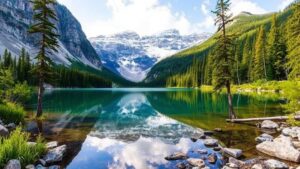Searching for the natural ice sculptures of the Mendenhall Ice Caves in Alaska.
Exploring the Natural Ice Sculptures of the Mendenhall Ice Caves in Alaska
The Mendenhall Glacier, located approximately 12 miles from Juneau, Alaska, is not only a breathtaking natural wonder but also a portal to the spectacular world of ice caves. These caves, formed by the dynamic processes of glacial movement, reveal stunning natural ice sculptures and offer a unique opportunity to experience the awe of polar beauty. This article delves into the Mendenhall Ice Caves, their formation, exploration, and safety considerations for visitors seeking to experience this remarkable part of Alaska.
Understanding the Mendenhall Glacier
The Mendenhall Glacier is part of the Juneau Icefield, which encompasses over 1,500 square miles of ice. It was named after the American geologist and botanist, Walter Mendenhall, who studied the area in the early 20th century. The glacier has been steadily retreating over the years, a phenomenon that is attributed to climate change.
As of 2023, Mendenhall Glacier extends approximately 12 miles in length and varies in width from about 1,500 to 2,000 feet. This massive river of ice has unique geological features, including crevasses, seracs, and, notably, ice caves. caves are created when meltwater carves out tunnels beneath the glacier, resulting in stunning formations that can include ice stalactites and vibrant blue-tinted ice.
The Ice Caves: A Natural Marvel
The Mendenhall Ice Caves captivate visitors with their magical blue lighting and intricate ice formations. These natural sculptures are often compared to a gothic cathedral, with high ceilings and majestic arches formed by the ice. The lighting within the caves is created by sunlight filtering through the translucent ice, resulting in an otherworldly glow that can change throughout the day.
While the caves can vary in size and depth, the best time to explore them is typically from mid-summer to early fall, when melting allows for safer entry into the cave systems. During peak conditions, visitors can find tunnels that reach up to 500 feet into the glacier.
Safety and Accessibility
Exploring the Mendenhall Ice Caves comes with inherent risks, and proper precautions are necessary. The ice can be unstable, with potential hazards including falling ice or sudden changes in temperature affecting structural integrity. Visitors must always be accompanied by a knowledgeable guide familiar with the conditions and nuances of the glacier.
For those interested in exploring the caves, it is advisable to:
- Join a guided tour to ensure safety and maximize the experience.
- Wear appropriate cold-weather gear, including insulated boots and waterproof clothing.
- Stay hydrated and maintain energy levels with nutritious snacks.
Real-World Applications and Environmental Considerations
The study of glaciers like Mendenhall has broader implications, particularly concerning climate science. ongoing retreat of the Mendenhall Glacier signifies larger global trends in climate change. This has sparked discussions about the importance of preserving natural environments and the need for sustainable tourism practices.
As visitors engage with the beauty of the Mendenhall Ice Caves, they also become part of the narrative surrounding climate change awareness and preservation of natural wonders. Educational programs at the nearby Mendenhall Glacier Visitor Center serve to inform the public about the history of the glacier and its ecological significance.
Actionable Takeaways
For those considering a visit to the Mendenhall Ice Caves, take these actionable steps:
- Plan your trip for the summer months for optimal weather conditions.
- Research and book guided tours in advance, as spaces can fill quickly during peak season.
- Familiarize yourself with environmental conservation efforts in the area to enhance your visit.
To wrap up, the Mendenhall Ice Caves represent not only natural beauty but also a vital component of our planets ecological narrative. By engaging with this remote part of Alaska, visitors can experience the serene magic of glacial ice and gain insight into the ongoing challenges facing our environment.


